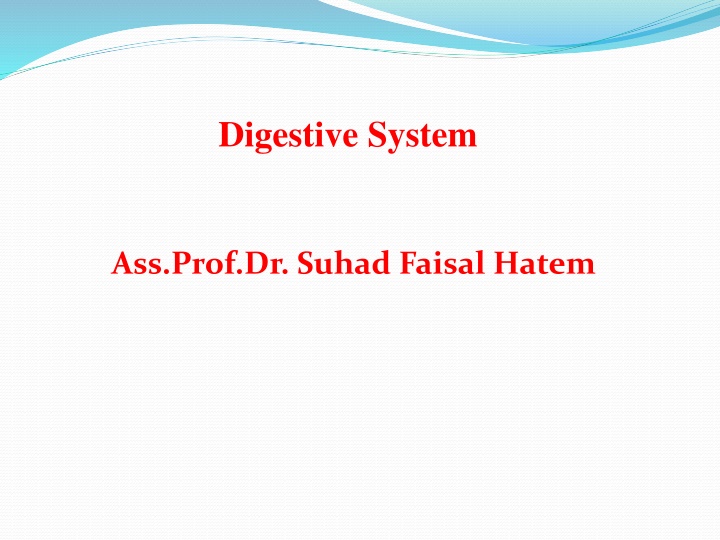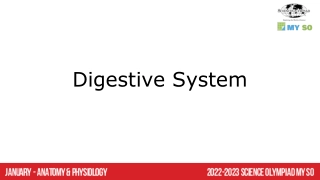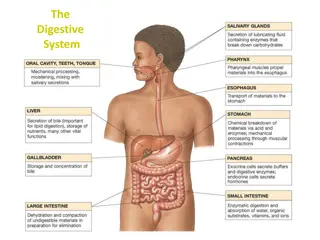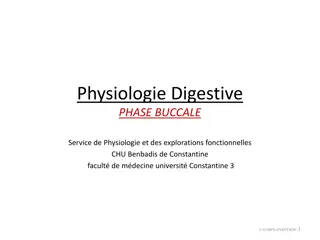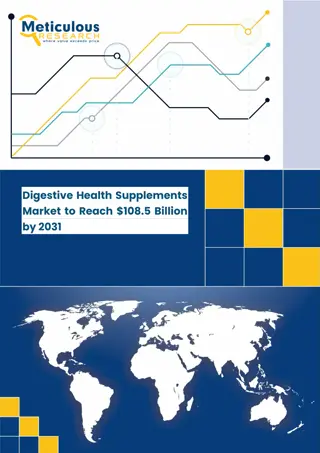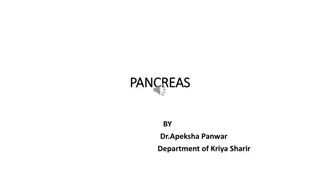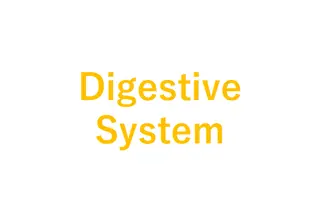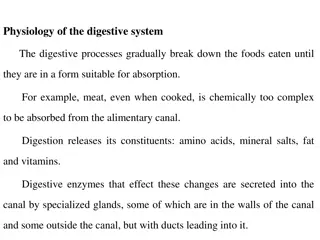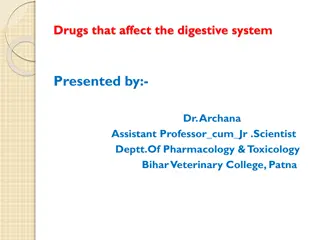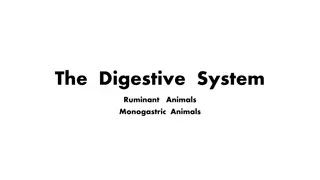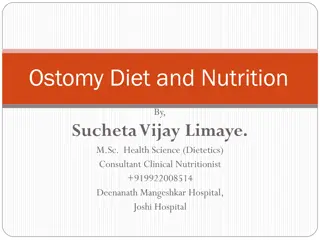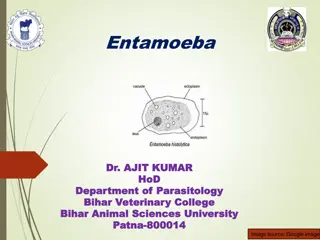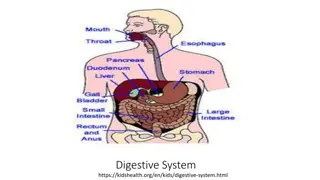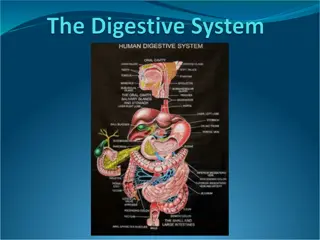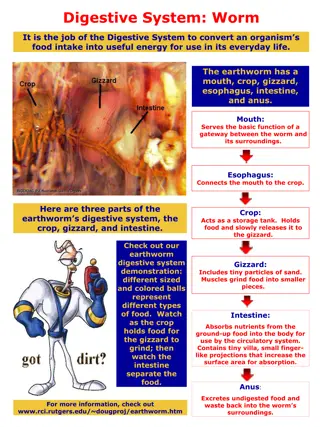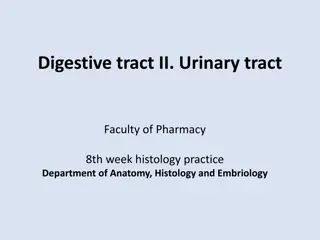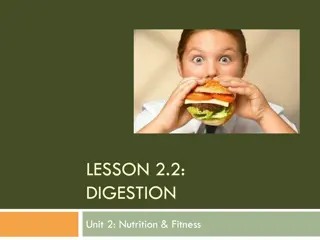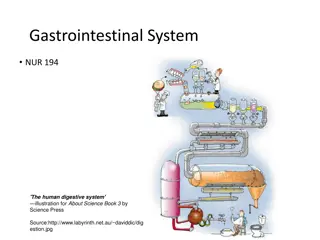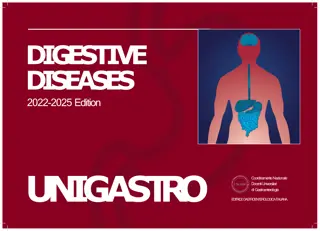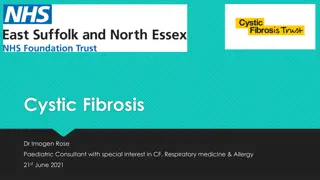Digestive System
The digestive system is a crucial component of our bodies, responsible for breaking down food, absorbing nutrients, and eliminating waste. It comprises various organs such as the mouth, esophagus, stomach, small and large intestines, and more. These organs work together to ensure proper digestion and nutrient absorption, facilitated by enzymes and muscle contractions. Understanding how the digestive system functions can help us maintain our overall health and well-being.
Download Presentation

Please find below an Image/Link to download the presentation.
The content on the website is provided AS IS for your information and personal use only. It may not be sold, licensed, or shared on other websites without obtaining consent from the author.If you encounter any issues during the download, it is possible that the publisher has removed the file from their server.
You are allowed to download the files provided on this website for personal or commercial use, subject to the condition that they are used lawfully. All files are the property of their respective owners.
The content on the website is provided AS IS for your information and personal use only. It may not be sold, licensed, or shared on other websites without obtaining consent from the author.
E N D
Presentation Transcript
Digestive System Ass.Prof.Dr. Suhad Faisal Hatem
The digestive system is a long continuous tube extending from the mouth to the anus .The main organs that make up the digestive system are Oral cavity Pharynx Esophagus Stomach Small and large intestines Anus accessory glands located within the wall of the tubular portion of the digestive tract salivary glands pancreas liver gallbladder Functions of the Digestive System Ingest food Break down food into simple nutrient molecules Absorb molecules into the bloodstream Rid the body of indigestible remains
The organs of the GI tract are lined with mucous membranes that secrete digestive enzymes and absorb nutrients. The organs are also covered by layers of muscle that enable peristalsis
Parts of the Digestive System 1-Mouth The digestive process begins in the mouth. Food is partly broken down by the process of chewing : chew your food into pieces that are more easily digested by teeth The major salivary enzyme is amylase. It begins the chemical digestion of carbohydrates by breaking down starch into sugar. tongue : When you swallow, passes the food into your throat and into your esophagus. The tongue helps mix the food with saliva and also helps the swallow. After you swallow, the chewed food passes into the pharynx.
2-Esophagus Located in your throat near your trachea ,the esophagus receives food from your mouth when you swallow. The epiglottis is a small flap that folds over your windpipe as you swallow to prevent you from choking. At the end of the esophagus, a muscle called a sphincter controls the entrance to the stomach. The sphincter opens to let food into the stomach and then closes again to prevent food from passing back into the esophagus
3-Stomach stomach is a sac-like organ in which food is further digested both mechanically and chemically that food being mixed with enzymes. These enzymes continue the process of breaking down food into a usable form. Cells in the lining of the stomach secrete a strong 1- hydrochloric acid (kill bacteria and give low acidity ) 2-powerful enzymes that are responsible for the breakdown process. Main enzyme is pepsin which digest proteins. When the small intestine is empty, a sphincter opens to allow the partially digested food to enter the small intestine.
Small Intestine Small intestines are roughly 22 feet long. Small refers to its diameter, not its length. Insides are coated with little fingers called villi to increase surface area. Nutrients from the food pass into the bloodstream diffuses through the small intestine walls. Lipids are first digested here by lipase (enzyme)
4-Small intestine the small intestine is a 7 meter long muscular tube that breaks down food using enzymes released by the pancreas and bile from the liver. Peristalsis also works in this organ, moving food through and mixing it with digestive juices from the pancreas and liver. Made up of three segments -- the duodenum, jejunum, and ileum duodenum is the first segment of the small intestine. Most chemical digestion takes place here. Lipase ,Maltase, peptidase enzyme secreted by duodenum. In addition to bile jejunum and ileum are mainly responsible for absorption of nutrients into the bloodstream. Ilem action reabsorb lipids ,B12,bile salt Contents of the small intestine start out semi-solid, and end in a liquid form after passing through the organ. Water, bile, enzymes and mucus contribute to the change in consistency Once the nutrients have been absorbed and the leftover-food residue liquid has passed through the small intestine to the large intestine, or colon
the mucous membrane lining of the jejunum is covered with millions of microscopic, fingerlike projections called villi . Villi contain many capillaries, and nutrients pass from the villi into the bloodstream through the capillaries.
Large Intestine About 5 feet long. Accepts what small intestines don t absorb. consists of three parts cecum ,colon, rectum Main Function: Absorbs water and minerals from the waste matter. The remaining solid wastes are called feces. Feces accumulate in the rectum, A sphincter controls the anus and opens to let feces pass.
Colon The large intestine, or colon, is responsible for processing waste so that emptying the bowels is easy and convenient. It s a 6-foot long muscular tube that connects the small intestine to the rectum. The large intestine is made up of the cecum, the ascending (right) colon, the transverse (across) colon, the descending (left) colon, and the sigmoid colon, which connects to the rectum. Stool, or waste left over from the digestive process, is passed through the colon by means of peristalsis, first in a liquid state and ultimately in a solid form. It normally takes about 36 hours for stool to get through the colon
Rectum The rectum is a straight, 8-inch chamber that connects the colon to the anus. The rectum's job is to receive stool from the colon, let you know that there is stool to be evacuated (pooped out) and to hold the stool until evacuation happens. When anything (gas or stool) comes into the rectum, sensors send a message to the brain. The brain then decides if the rectal contents can be released or not. If they can, the sphincters relax and the rectum contracts, disposing its contents. If the contents cannot be disposed, the sphincter contracts and the rectum accommodates so that the sensation temporarily goes away.
Anus The anus is the last part of the digestive tract. It is a 2-inch long canal consisting of the pelvic floor muscles and the two anal sphincters (internal and external). The lining of the upper anus is able to detect rectal contents. It lets you know whether the contents are liquid, gas or solid. The anus is surrounded by sphincter muscles that are important in allowing control of stool.
Accessory glands Other organs involved in digestion include the liver, gall bladder, and pancreas. They are called accessory organs because food does not pass through them. Instead, they secrete or store substances needed for digestion. Liver Function 1. Directly affects digestion by producing bile. Bile has digestive enzymes lipase and releases them into the small intestines for digestion. Function 2. Processes nutrients in the blood, filters out toxins and waste. Drinking alcohol, drugs, or taking too many medications damages the liver.
Liver The liver is an organ of both digestion and excretion. It produces a fluid called bile, which is secreted into the duodenum The liver has many functions, but its main job within the digestive system is to process the nutrients absorbed from the small intestine. Bile from the liver secreted into the small intestine also plays an important role in digesting fat and some vitamins. The liver is the body's chemical "factory." It takes the raw materials absorbed by the intestine and makes all the various chemicals the body needs to function. The liver also detoxifies potentially harmful chemicals. It breaks down many drugs that can be toxic to the body.
Gall Bladder a sac-like organ that stores and concentrates bile and then secretes it into duodenum in the small intestine to help digest and absorb fats Produce lipase to digests lipids bile breaks up large globules of lipids into smaller globules that are easier for enzymes to break down Bile also reduces the acidity of food entering from the highly acidic stomach. This is important because digestive enzymes that work in the duodenum need a neutral environment. .
Pancreas The pancreas secretes digestive enzymes into the duodenum that break down protein, fats and carbohydrates Neutralizes acids that enter small intestine. The pancreas contributes to the neutral environment by secreting bicarbonate, a basic substance that neutralizes acid. Regulates blood sugar by producing insulin. If it doesn t work right you develop diabetes.
